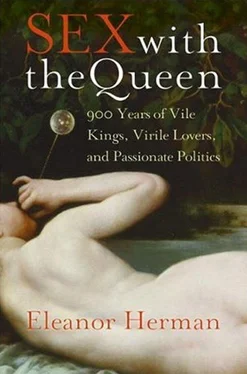Henry, trying hard to believe the allegations which would enable him to marry his sweetheart Jane Seymour in a matter of days, wallowed in self-pity. Most kings with unfaithful wives— truly unfaithful wives—went to great efforts to obtain a divorce without mention of the word adultery , which cast suspicion on children of the marriage a well as the king’s virility. The Spanish ambassador wrote that no man ever paraded with such frequency the fact that his wife had betrayed him, and with so little sign that he minded. Henry multiplied the number of Anne’s lovers until he was convinced she had had no less than a hundred of them.
At her adultery trial on May 15, the queen was accused with dates and places. Yet many are clearly impossible. Two of the dates are October 6 and 12, 1533, at Westminster Palace when Anne was still recuperating from the September birth of Princess Elizabeth. Locked in a darkened room, surrounded by clucking ladies, the queen was not permitted to leave until her “churching” ceremony later in the month. Her supposed rendezvous with Mark Smeaton at Greenwich Palace on May 13, 1535, was also untrue; the queen was then residing at Richmond Palace. Out of twenty encounters, eleven were clearly fabricated.
Oddly, none of Anne’s ladies was charged along with her as accessory to her adultery. And surely Henry, in his sweeping capture of knights, pawns, and the queen on his chessboard, would have captured errant ladies-in-waiting. Yet none was ever mentioned—further proof of her innocence.
One eyewitness of the queen’s trial reported, “She made so wise and discreet answers to all things laid against her, excusing herself with her words so clearly as though she had never been faulty to the same.” 22
And yet it was clear that Anne had enjoyed flirtations with handsome young courtiers; numerous witnesses attested to it. Before a tribunal of cold-faced judges, jollity of any nature sounds sinful. And particularly for a queen accused of adultery, reports of laughing, flirting, and dancing seemed damning evidence of her sins. It would have been harder to accuse a dull, plodding queen who spent most of her time in church.
Evidently Anne’s vivacity was enough to condemn her. The court found, “Because thou has offended our sovereign the king’s grace in committing treason against his person and here attainted of the same, the law of the realm is this, that thou hast deserved death, and thy judgment is this: that thou shalt be burned here within the Tower of London, or on the Green, else to have thy head smitten off, as the king’s pleasure shall be further known of the same.” 23An odd thing happened when Anne’s puppet strings were cut—the puppets remained standing; it was the puppeteer who fell down limp.
Anne was only twenty-nine when she emerged pale and dry-eyed from her long night’s vigil in the Tower of London to walk to the scaffold prepared for her. Eyewitnesses reported that on that day, May 19, 1536, she was breathtakingly beautiful. Underneath her white ermine cloak, she wore a black velvet gown edged with pearls over a red quilted petticoat—colors chosen, perhaps, to conceal the blood that would soon wash over them. Anne’s behavior had rarely if ever been queenly; but on this day she was truly regal.
The scaffold was three or four feet high, draped in black, surrounded by a crowd, the Lord Mayor and alderman and hundreds of ordinary Englishmen; no foreigners were permitted to see an English queen die. She was given four loyal ladies-in-waiting to accompany her to the edge of eternity.
Witnesses said that on her walk to the scaffold—a walk all too long, all too short—she kept turning around looking perhaps for a messenger to come bearing a royal pardon. She must have hoped that in the last moment, the king, who had once so loved her, would not let her die. Perhaps he would exile her to France, arrange for her to take nun’s vows and become an abbess. But after she climbed the scaffold and took one last look around, there was still no messenger.
In the sixteenth century a condemned person was supposed to humbly accept God’s will and show courage in the concluding scene that would define an entire life. Ranting against injustice, protesting one’s innocence, or trembling with fear was considered to be in very poor taste. Knowing her part, Anne strode front and center for her address. “Good Christian people, I have not come here to preach a sermon; I have come here to die,” she began. “For according to the law and by the law I am judged to die, and therefore I will speak nothing against it.
“I am come hither to accuse no man, nor to speak of that whereof I am accused and condemned to die, but I pray God save the king and send him long to reign over you, for a gentler nor a more merciful prince was there never, and to me he was ever a good, a gentle, and sovereign lord. And if any person will meddle in my cause, I require them to judge the best. And thus I take my leave of the world and of you all, and I heartily desire you all to pray for me.” 24
Anne spoke “with a goodly smiling countenance.” 25We can picture her low clear voice carrying over the crowd as the spectators bent forward to catch each word. After her speech, her ladies, weeping, removed her ermine mantle. Anne took off her headdress, showing for a moment the shining raven’s wing hair that had bewitched a king, then tucked it up under a cap. This and her low neckline would avoid dulling the sharp stroke of the blade.
She bade farewell to her attendants. One of them tied a handkerchief around her eyes so she would not see the blow coming. She knelt down and repeated the words, “Jesu, receive my soul; O Lord God, have pity on my soul. To Christ I commend my soul!” 26Suddenly, with one swift blow, it was over, her head rolling on the scaffold. The executioner held it up by the hair. The lips were still moving in prayer.
Her ladies covered the bleeding torso, the bleeding head, in white drapes that all too soon became red, a seething growing inundating red. Neither Henry nor the Tower constable had thought about a coffin for the queen, and so she was placed in a box used to ship bow-staves from the Tower Armory to Ireland. But the box was too short. Only the torso would fit, and her head was tucked underneath her arm. Indeed, it was by this story that nineteenth-century workmen identified her body when they repaved the church in which she had been buried. It was a poor resting place for a queen executed for adultery she did not commit.
CATHERINE HOWARD, QUEEN OF ENGLAND
“Rose without a Thorn”
After Anne Boleyn’s death, the religious reform party was stymied at the advent of her successor, the Catholic Jane Seymour. Important positions at court were taken away from the disgraced Boleyn supporters and given to the Seymour family and their friends. But Jane died in childbirth barely a year after her marriage, and Henry chose as his fourth queen the Protestant Anne of Cleves. Suddenly the reformers were in power, and the Catholics in despair.
Catholics at court hoped to find a young mistress for the king whom they could use to balance the scales in their favor. Anne Boleyn’s uncle, Lord Thomas Howard, duke of Norfolk, who had obtained royal permission to remain Catholic throughout the English reformation, was now itching to throw one of his numerous attractive nieces into the royal bed. He was delighted when nineteen-year-old Catherine Howard, a new maid of honor to Anne of Cleves, came to court and immediately won the king’s favor. One Howard relative reported that the “King’s Highness did cast a fantasy to Catherine Howard the first time that ever his Grace saw her.” 27
It would be a meteoric rise in the fortunes of a neglected girl. As a daughter of an impoverished younger son of the Howard clan, her mother dead, Catherine was sent at about the age of ten to live with the crusty old matriarch of the Howards, Agnes, dowager duchess of Norfolk. Catherine slept with other girls and servants in a dormitory on the top floor of the house. As the years passed she grew into a beautiful voluptuous teenager, but her mind remained that of a child, empty-headed, thoughtless, and impetuous.
Читать дальше












